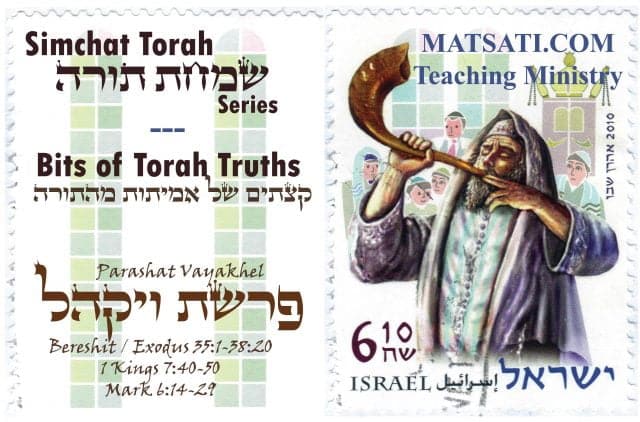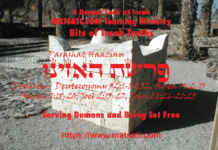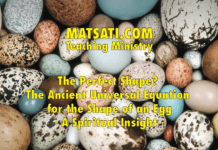[youtube url=”https://www.youtube.com/watch?v=6mG0vNlBWX8&feature=youtu.be”]
This weeks reading is from Parashat Vayak’hel (Shemot / Exodus 35:1-38:20), Moshe assembled the entire congregation of Israel and said וַיֹּאמֶר אֲלֵהֶם אֵלֶּה הַדְּבָרִים אֲשֶׁר-צִוָּה יְהוָֹה לַעֲשֹת אֹתָם “These are the things that the Lord has commanded you to do.” (NASB) They are to keep the seventh day as holy to the Lord, no work is to be done on the Shabbat (יִהְיֶה לָכֶם קֹדֶשׁ שַׁבַּת שַׁבָּתוֹן). A Terumah (contribution) is to be made to the Lord like it was described in Parashat Terumah (קְחוּ מֵאִתְּכֶם תְּרוּמָה לַיהֹוָה). Gold, silver, bronze, blue, purple, and scarlet material, goats hair, rams’ skins, porpoise skins, acacia wood, olive oil, incense, and onyx stones for the setting of the ephod and breastplate (35:5-9, זָהָב וָכֶסֶף וּנְחֹשֶׁת: ו וּתְכֵלֶת וְאַרְגָּמָן וְתוֹלַעַת שָׁנִי וְשֵׁשׁ וְעִזִּים). Moshe describes the construction of the Tabernacle (35:10-19). Moshe called Bazalel and Oholiab to begin the work of building the sanctuary (35:26-36:2, ל וַיֹּאמֶר מֹשֶׁה אֶל-בְּנֵי יִשְֹרָאֵל רְאוּ קָרָא יְהוָֹה בְּשֵׁם בְּצַלְאֵל בֶּן-אוּרִי בֶן-חוּר לְמַטֵּה יְהוּדָה:). The scripture details the construction of the curtains (36:9-18), the walls of the Tabernacle (36:19-37), and the Ark of the Covenant (37:1-15). The utensils used for the daily sacrifice were constructed (37:16) and the menorah was constructed (37:17-22). The altar of incense was constructed from acacia wood and overlaid with pure gold (37:25-29). The altar for the burnt offering was constructed next (38:1-7) and it was overlaid with bronze and the laver was then constructed (38:8). The remainder of the Parashah details the construction of the court of the Tabernacle (38:38:9-20). Moshe gives an accounting of the materials used in the construction of the Tabernacle constructed by Betzalel and Oholiab. Following the construction of the Mishkhan, Moshe assembles everything, anoints them with oil, and commissions Aaron and his sons into the priestly service.
Studying this week’s Torah portion it is interesting what the Scriptures say concerning the construction of the bronze laver. Moshe writes in the Torah saying, ח וַיַּעַשֹ אֵת הַכִּיּוֹר נְחשֶׁת וְאֵת כַּנּוֹ נְחֹשֶׁת בְּמַרְאֹת הַצֹּבְאֹת אֲשֶׁר צָבְאוּ פֶּתַח אֹהֶל מוֹעֵד: 38:8 Moreover, he made the laver of bronze with its base of bronze, from the mirrors of the serving women who served at the doorway of the tent of meeting. (NASB) The bronze laver was made from the mirrors of the serving women. What does that mean? When the priests washed their hands, would they see themselves? Were the mirrors made of bronze which was then transformed into the laver? Apparently, the statement regarding the mirrors being used for the construction of the laver has a very significant meaning which we will discuss.
ספר שמות פרק לח
א וַיַּעַשֹ אֶת-מִזְבַּח הָעֹלָה עֲצֵי שִׁטִּים חָמֵשׁ אַמּוֹת אָרְכּוֹ וְחָמֵשׁ-אַמּוֹת רָחְבּוֹ רָבוּעַ וְשָׁלֹשׁ אַמּוֹת קֹמָתוֹ: ב וַיַּעַשֹ קַרְנֹתָיו עַל אַרְבַּע פִּנֹּתָיו מִמֶּנּוּ הָיוּ קַרְנֹתָיו וַיְצַף אֹתוֹ נְחֹשֶׁת: ג וַיַּעַשֹ אֶת-כָּל-כְּלֵי הַמִּזְבֵּחַ אֶת-הַסִּירֹת וְאֶת-הַיָּעִים וְאֶת-הַמִּזְרָקֹת אֶת-הַמִּזְלָגֹת וְאֶת-הַמַּחְתֹּת כָּל-כֵּלָיו עָשָֹה נְחֹשֶׁת: ד וַיַּעַשֹ לַמִּזְבֵּחַ מִכְבָּר מַעֲשֵֹה רֶשֶׁת נְחֹשֶׁת תַּחַת כַּרְכֻּבּוֹ מִלְּמַטָּה עַד-חֶצְיוֹ: ה וַיִּצֹק אַרְבַּע טַבָּעֹת בְּאַרְבַּע הַקְּצָוֹת לְמִכְבַּר הַנְּחֹשֶׁת בָּתִּים לַבַּדִּים: ו וַיַּעַשֹ אֶת-הַבַּדִּים עֲצֵי שִׁטִּים וַיְצַף אֹתָם נְחֹשֶׁת: ז וַיָּבֵא אֶת-הַבַּדִּים בַּטַּבָּעֹת עַל צַלְעֹת הַמִּזְבֵּחַ לָשֵֹאת אֹתוֹ בָּהֶם נְבוּב לֻחֹת עָשָֹה אֹתוֹ: ס ח וַיַּעַשֹ אֵת הַכִּיּוֹר נְחשֶׁת וְאֵת כַּנּוֹ נְחֹשֶׁת בְּמַרְאֹת הַצֹּבְאֹת אֲשֶׁר צָבְאוּ פֶּתַח אֹהֶל מוֹעֵד:Shemot / Exodus 38:1-8
38:1 Then he made the altar of burnt offering of acacia wood, five cubits long, and five cubits wide, square, and three cubits high. 38:2 He made its horns on its four corners, its horns being of one piece with it, and he overlaid it with bronze. 38:3 He made all the utensils of the altar, the pails and the shovels and the basins, the flesh hooks and the firepans; he made all its utensils of bronze. 38:4 He made for the altar a grating of bronze network beneath, under its ledge, reaching halfway up. 38:5 He cast four rings on the four ends of the bronze grating as holders for the poles. 38:6 He made the poles of acacia wood and overlaid them with bronze. 38:7 He inserted the poles into the rings on the sides of the altar, with which to carry it. He made it hollow with planks. 38:8 Moreover, he made the laver of bronze with its base of bronze, from the mirrors of the serving women who served at the doorway of the tent of meeting. (NASB)
Moshe writes in the Torah saying, ח וַיַּעַשֹ אֵת הַכִּיּוֹר נְחשֶׁת וְאֵת כַּנּוֹ נְחֹשֶׁת בְּמַרְאֹת הַצֹּבְאֹת אֲשֶׁר צָבְאוּ פֶּתַח אֹהֶל מוֹעֵד: 38:8 Moreover, he made the laver of bronze with its base of bronze, from the mirrors of the serving women who served at the doorway of the tent of meeting. (NASB) According to the Scriptures, the bronze laver (הַכִּיּוֹר) or wash basin was made from the mirrors of the serving women. A mirror is a flat or a curved surface usually produced of glass that has had a reflective coating applied to it. The reflection was most likely discovered by looking into pools of water, streams and rivers which acted as the first mirrors. In ancient times, the earliest man made mirrors were from polished stone or metal. In this case, it is very likely that the mirrors of the women who served at the entrance to the Tent of Meeting, had mirrors made of polished bronze. These bronze mirrors were then transformed into the laver. An interesting concept here is as a result of the mirrors being transformed into the laver, when the priests washed their hands, they would see themselves, and be reminded that they are imperfect people serving a perfect God.
The rabbis have the following to say concerning the mirrors of the serving women and the bronze laver.
Daat Zkenim on Exodus 38:8, part 1
במראות הצובאות, “with the mirrors of the serving women.” (Women chastely performing tasks near the entrance of the Tabernacle) Moses wished that the women could observe how their mirrors donated for the construction of the Tabernacle had been used as a polished cover for the altar situated in front of the entrance to the Tabernacle. This was next to the washbasin for the priests from which they washed their hands and feet, and from the waters contained therein that a woman suspected of infidelity, Sotah would be made to drink in order to prove that she was innocent of that sin.
Daat Zkenim provides a rabbinic interpretation that the mirrors were used to construct a polished cover for the altar. It is interesting how the mirrors that were donated for the wash basin used for washing the hands and feet, is also the waters from which one drinks in order for a wife to prove she was innocent of the sin of unfaithfulness. This draws in the concept of the wash basin being polished, and when one washed the hands and feet, one saw himself in the reflection, not only from the water but also from the polished bronze. The point is that the priest was conscious of his sins before God since the washing was performed prior to entering into the Tabernacle. In a similar manner, both the husband and wife would be conscious of their sins when going before the Lord for the waters of the Sotah.
Sforno has the following to say:
Sforno on Exodus 38:8, Part 1-2
במראות הצובאות, this was not included in the נחושת התנופה, “copper for the waving,” as explained in verse 30 of this chapter in Parshat Pekudei. The copper basin and its stand are mentioned as having been constructed from the amount of copper representing these mirrors. אשר צבאו פתח אהל מועד, approaching this holy domain was intended to show that they wanted to hear the words of the living G’d. That this was an acceptable practice is already documented in 33,7 והיה כל מבקש ה’ יצא אל אהל מועד, “anyone who wanted to seek out the Lord would go out to the Tent of Meeting.” The women who had donated these mirrors indicated that they had overcome their sense of vanity, they considered jewelry and the need for it a human weakness. Moreover, they knew that the time when these mirrors had been of constructive use was past. (במראות הצובאות שלא היה בכלל נחשת התנופה, כמו שמבואר בפרשת פקודי, באמרו ויעש בה וגו’ ולא הזכיר כיור וכנו בכלל הנעשים ממנה: אשר צבאו פתח אהל מועד לשמוע דברי אלהים חיים, כאמרו והיה כל מבקש ה’ יצא אל אהל מועד. ואותן הנשים מאסו עניני תכשיטיהן, והקדישו מראותיהן להורות שאינן צריכות עוד להן:)
According to Sforno, the copper basin was created with a representative amount, and the mentioning of the women who had donated the mirrors indicated their overcoming the sense of vanity, where jewelry and mirrors are considered a human weakness due to the sin of vanity.
Rashi has the following to say:
Rashi on Exodus 38:8
from the mirrors of the women who had set up the legions: Heb. בְּמַרְאֹת הַצֹבְאֹת Israelite women owned mirrors, which they would look into when they adorned themselves. Even these [mirrors] they did not hold back from bringing as a contribution toward the Mishkan, but Moses rejected them because they were made for temptation [i.e., to inspire lustful thoughts]. The Holy One, blessed is He, said to him, “Accept [them], for these are more precious to Me than anything because through them the women set up many legions [i.e., through the children they gave birth to] in Egypt.” When their husbands were weary from back-breaking labor, they [the women] would go and bring them food and drink and give them to eat. Then they [the women] would take the mirrors and each one would see herself with her husband in the mirror, and she would seduce him with words, saying, “I am more beautiful than you.” And in this way they aroused their husbands desire and would copulate with them, conceiving and giving birth there, as it is said: “Under the apple tree I aroused you” (Song 8:5). This is [the meaning of] what is בְּמַרְאֹת הַצֹבְאֹת [lit., the mirrors of those who set up legions]. From these [the mirrors], the washstand was made, because its purpose was to make peace between a man and his wife. [How so?] By giving a drink from the water that was in it [the washstand] to [a woman] whose husband had warned her [not to stay in private with a certain man] and she secluded herself [with him anyway. The water would test her and either destroy her or prove her innocence. See Num. 5:11-31]. You should know that they were actually mirrors, because it is said: “The copper of the waving was seventy talents… From that he made…” (Exod. 38:29, 30), but the washstand and its base were not mentioned there [among the things produced from the seventy talents. Thus,] you have learned that the copper of the washstand was not of the copper of the waving. So did Rabbi Tanchuma expound [on the matter] (Midrash Tanchuma, Pekudei 9; Num. Rabbah 9:14). And so did Onkelos render: בְּמֶחְזְיַת נְשַׁיָא [“the mirrors of the women”], which is the Aramaic translation of מַרְאוֹת, mirrors in French. So we find in Isaiah (3:23) וְהַגִּלְיֹנִים (sic), which we render: וּמַחְזְיָתָא, and the mirrors.
According to Rashi, Moshe rejected the mirrors for the construction of the Tabernacle because it is related to temptation in the sense of lustful thoughts. The Lord however told Moshe to accept them, because it is through them the women bore many children. This draws in the idea of the yetzer hara and the yetzer hatov, both of which the Lord God had created and given to man. Lustful thoughts are related to the yetzer hara, where without the yetzer hara a man would not build a house, take a wife, or have children as we read here according to Rashi and elsewhere in the rabbinic literature. According to Rashi, the mirror was used by the woman to seduce the man, and so was used as a way to make peace between a husband and wife. All of these things tie together the concepts of the husband, wife, the sotah, mirrors, and the wash basin.
Shney Luchot HaBrit has the following to say:
Shney Luchot HaBrit, Vayikra, Torah Ohr 37
Our sages added that the animal first has to be thrown to the ground forcefully as a symbol of man having thrown down his own person, thereby confessing that he himself is guilty of death by stoning. When the animal is slaughtered this is equivalent to the owner killing himself suggesting that he is guilty of the two death penalties: death by the sword and by hanging. (There is a momentary feeling of choking experienced by the animal before the knife slices through its throat). When the animal is burned on the altar, this symbolizes the fourth kind of death penalty, death by burning. The owner of the animal recites a confession and G’d accepts it. The priest must also see to it that at the time when he sprinkles the animal’s blood on the altar the man or woman for whom he performs this service should observe what he is doing. The priest is not himself allowed to look directly at a woman while he performs service in the precincts of the Temple; the copper laver used in the Temple was made of the mirrors the Jewish women used in Egypt when they prettied themselves for their husbands; when the priest offers a sin-offering owned by a woman he looks at this copper laver and sees her reflection in it. This has been explained by the Rekanati. The rule we learn from all that we have described above is that the person who offers the sacrifice should regard himself as being sacrificed. He is then fulfilling (2,1): ונפש כי תקריב קרבן מנחה “When a person sacrifices (himself) as a gift-offering.”
Notice how Shney Luchot HaBrit, Vayikra, Torah Ohr 37 relates all of these things together, the animal for sacrifice, death by stoning and by sword, the animal being burned upon the altar, lustful thoughts during the priestly service, the copper laver, and the mirrors of the women who served at the entrance to the Tent of Meeting. All of these things come together and may be interpreted as “The rule we learn from all that we have described above is that the person who offers the sacrifice should regard himself as being sacrificed. He is then fulfilling (2,1): ונפש כי תקריב קרבן מנחה ‘When a person sacrifices (himself) as a gift-offering.’” The concept may be related here to what the Apostle Paul wrote in Romans 12:1 Therefore I urge you, brethren, by the mercies of God, to present your bodies a living and holy sacrifice, acceptable to God, which is your spiritual service of worship. 12:2 And do not be conformed to this world, but be transformed by the renewing of your mind, so that you may prove what the will of God is, that which is good and acceptable and perfect. (NASB) These concepts of the laver, the mirrors, animal sacrifice, the Sotah, etc draw in the realization of our short comings, and the need for the mercy and grace of God and His forgiveness.
In this week’s Torah Portion (Parashat Vayak’hel), it is important to note that the items given for the construction of the Tabernacle were a Terumah, a voluntary contribution. The Torah says “from every person whose heart moves him” in relation to the laver being made from the mirrors of the woman who served at the entrance of the Tent of Meeting. These women gave of themselves, they gave up their vanity for the service of the Lord. According to the Rabbis, the laver assumed the character of those mirrors in the sense that the laver brought out something about the person who was involved in the service to the Lord, the priest would wash bringing to memory the nature of his sins before God, similar to the case of the Sotah, where a husband and wife would come before the Lord, the mirror of the laver reminded them of their sins in the covenant relationship (marriage) were made known before God. According to the sages, it is no coincidence that the Sotah, was made to drink from the water of this laver which was made from the mirrors of the women who were dedicated to holiness. It is fitting therefore that it was used to reveal the truth in case of a woman who deviated from holiness in her covenant relationship with her husband. This stood as a constant reminder for the priest, of his sins and unfaithfulness that he may have been committed in his covenant relationship wit the Lord God in heaven. If we consider the context of these things, the laver also represents washing away the ego, selfishness, and negative feelings towards others.
Before the priest entered the Tabernacle, he would ceremoniously wash his hands and feet at a special bronze laver, symbolically ridding himself of sin before approaching the Lord God. Considering mirrors were used in the construction of the laver, the bronze laver may have been a giant mirror. What was the function of a mirror like laver? When the priest would wash peering into a mirror, he would see not only himself, but everything behind him. Note that the laver would have reflected the sky above as an illustration of the throne of God in the heavens. As a result, the priest would have brought to mind his origin, the Creator, and the purpose for which his soul was sent to earth, his purpose in life, to serve the Lord. He would have been reminded of his sins which would lead to his repentance and confession before God just prior to entering the Tabernacle.
The essential part from this week’s Torah portion based upon these Scriptures, is the function of the laver represents our lives in the Messiah Yeshua. We come to the realization that we are not perfect, and need a savior. The Apostle John wrote in 1 John 1:7 but if we walk in the Light as He Himself is in the Light, we have fellowship with one another, and the blood of Jesus His Son cleanses us from all sin. (NASB) The context of walking in the light is to that of living in righteousness before God. Yeshua cleansing us in his blood (atoning sacrifice), and our walking in righteousness (being washed by the word) are all concepts that have been drawn out by the rabbis in their commentaries on the laver. These things are connected to having an intimate union between a man and his wife in a covenant relationship, which parallels our relationship with the Father in heaven in Yeshua the Messiah. The Sotah represents our guilt before God and sin. Yeshua said in John 7:37, “If any man thirst let him come to Me and drink,” it was on the great day of the feast of tabernacles when the Jewish leaders were pouring the water from the pool of Siloam (בריכת השילוח). This is a reference to the words of the prophet Ezekiel.
Ezekiel 36:25-34
36:25 ‘Then I will sprinkle clean water on you, and you will be clean; I will cleanse you from all your filthiness and from all your idols. 36:26 ‘Moreover, I will give you a new heart and put a new spirit within you; and I will remove the heart of stone from your flesh and give you a heart of flesh. 36:27 ‘I will put My Spirit within you and cause you to walk in My statutes, and you will be careful to observe My ordinances. 36:28 ‘You will live in the land that I gave to your forefathers; so you will be My people, and I will be your God. 36:29 ‘Moreover, I will save you from all your uncleanness; and I will call for the grain and multiply it, and I will not bring a famine on you. 36:30 ‘I will multiply the fruit of the tree and the produce of the field, so that you will not receive again the disgrace of famine among the nations. 36:31 ‘Then you will remember your evil ways and your deeds that were not good, and you will loathe yourselves in your own sight for your iniquities and your abominations. 36:32 ‘I am not doing this for your sake,’ declares the Lord God, ‘let it be known to you. Be ashamed and confounded for your ways, O house of Israel!’ 36:33 ‘Thus says the Lord God, ‘On the day that I cleanse you from all your iniquities, I will cause the cities to be inhabited, and the waste places will be rebuilt. 36:34 ‘The desolate land will be cultivated instead of being a desolation in the sight of everyone who passes by. (NASB)
The laver draws in the context of all these things, recognizing we need cleansed form our sins, repentance, and receiving the forgiveness of God in heaven, and of the Messiah Yeshua through whom all of these things are possible. BTT_Parashat Vayak’hel 2016









